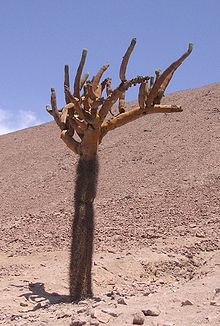|
Rebutiinae
The Rebutiinae are a subtribe of cacti belonging to the subfamily Cactoideae, tribe Cereeae.[1] A 2010 classification accepted seven or eight genera, but when circumscribed in this way, the subtribe was not monophyletic. A 2023 classification reduced Rebutiinae to three genera. DescriptionRebutiinae are large tree-like or shrubby plants. Their columnar shoots are articulated or not articulated. The ribs are usually heavily spined. The medium to large flowers appearing on the side usually open at night. Their pericarpel has imbricated scales. The areoles have thorns or bristles. The fleshy fruits are not bursting, scaly, thorned or glabrous. The medium-sized to large seeds are often wrinkled. The hilum and micropyle of the seeds are fused, an appendage is absent, and a mucous sheath is sometimes present. TaxonomyIn a 2010 classification of the tribe Cereeae, the subtribe Rebutiinae comprised seven or eight genera, depending on whether Aylostera was recognized as separate from Rebutia. It was accepted that with this circumscription the subtribe was not monophyletic.[2][3] A 2023 molecular phylogenetic study confirmed that the subtribe was not monophyletic, and proposed a reduced subtribe of just three genera.[4] GeneraIn the 2023 classification, the subtribe contains three genera:[4]
Former generaThe following genera were formerly placed in Rebutiinae:[4]
References
|
||||||||||||||||||||||||||||||||||||||||||||||||||



